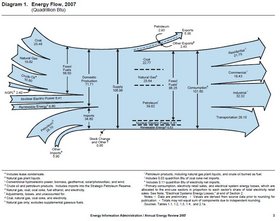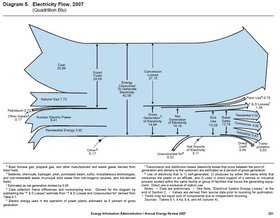Climate Solutions: Chapter 7
| Topics: |
Contents
The Inefficiency of Automobiles
Global climate change … time and geographic scales are unprecedented in their scope, touching every human activity that involves energy or land and requiring a strategy that stretches a century or more into the future. The actions needed to manage the risks of climate change require long-term commitments to severely limit net emissions of greenhouse gases to the atmosphere by developing and deploying new ways of producing and using energy across the world. [4]
—Jae Edmonds, Global Energy Technology Strategy Program, 2007
Utilities made their money by building stuff ... because they were rewarded by their regulators with increased rates on the basis of those capital expenses. The more capital they deployed, the more they made.… We are not going to regulate our way out of the problems of the Energy-Climate Era. We can only innovate our way. Pp. 222, 243
—Thomas Friedman, 2008
As much as we love cars, the typical car is not an efficient transportation device, for two big reasons: An internal combustion engine converts much of the fuel energy to waste heat, and most cars are far heavier than they need to be. There are many ways to measure efficiency. For example, we could use the ratio of the object being moved to the object doing the moving. Americans use 680 kilograms (1,500 pounds) of metal and plastic in the form of an average passenger car to transport an average adult who weighs 68 kilograms (150 pounds). So the “efficiency” of the automobile cannot exceed 10%—the fraction of the car’s total mass represented by the passenger (150 divided by 1,500). But this calculation is misleading. The mass of a car affects efficiency only indirectly, by increasing friction and conversion of energy to heat during braking, especially in stop-and-go traffic. Hybrids in which this energy is recaptured lose less energy to heat. Shedding vehicle weight would make gas mileage go up, even without changing the engine itself, as a lower weight reduces friction.
The efficiency of a typical car is limited through the underlying physics of burning hydrocarbons. Internal combustion engines are not efficient in their conversion of the chemical energy in gas or diesel fuel to mechanical energy for the drivetrain. The “fuel-to-wheel” efficiency for automobiles is about 20%. [18] Only about one-fifth of the chemical energy in a gasoline tank actually reaches the drivetrain as mechanical energy to move the vehicle. All the rest—about 80%—of the energy in your gas tank is used for something else other than driving. Where does the energy go? The “lost” energy escapes as evaporation, waste heat, internal friction, and exhaust gas.
A typical car traveling at 65 kilometers (40 miles) per hour on a level road consumes 7.6 liters per hour (2 gallons), which represents about 72 kilowatts (kW) of chemical energy. In the combustion process of a gasoline engine, four-fifths (57 kW) of the original chemical energy is lost as heat. The engine converts the remaining energy (about 14 kW) in the gasoline into the mechanical energy to drive the lights, fan, generator, water pump, transmission, and drive train. These components shed almost one-third of mechanical energy as heat (about 5 kW). Of the remaining mechanical energy, about half is expended as air friction and half goes into actually turning the tires on a road via friction. Only about 10 of the original 72 kW are available for forward (or backward) motion. In short, the thermodynamic efficiency of using internal combustion engines in our cars represents an actual energy efficiency of just under 14%. [16]
Online figures
Bibliography
- Baumert K, Herzog T, Pershing J (2005) Navigating the Numbers: Greenhouse Gas Data and International Climate Policy, 122. (World Resources Institute). http://www.wri.org
- CBC News (2003) Power Outage Background November 13, 2003 (read September 4, 2008). http://www.cbc.ca/news/background/poweroutage/
- Clarke L, Edmonds J, Jacoby H, Pitcher H, Reilly J, Richels R (2007) Scenarios of Greenhouse Gas Emissions and Atmospheric Concentrations. (Sub-report 2.1A of Synthesis and Assessment Product 2.1). http://www.climatescience.gov/Library/sap/sap2-1/finalreport/default.htm
- Edmonds JA, Wise MA, Dooley JJ, Kim SH, Smith SJ, Runci PJ, Clarke LE, Malone EL, Stokes GM (2007) Global Energy Technology Strategy: Addressing Climate Change. Global Energy Technology Strategy Program. http://www.pnl.gov/gtsp/publications/
- Epstein P (2008) Healthy Solutions for the Low Carbon Economy: Guidelines for Investors, Insurers and Policy Makers. The Center for Health and the Global Environment. Harvard Medical School. http://chge.med.harvard.edu/programs/ccf/
- Friedman T (2008) Hot, Flat and Crowded: Why We Need a New Green Revolution and How It Can Renew America, 410. (Farrar, Straus, and Giroux, New York). http://www.thomaslfriedman.com
- Govtrack.us (2007) Energy Efficient Lighting for a Brighter Tomorrow Act of 2007. GovTrack.us (Database of federal legislation) (read October 25, 2008). http://www.govtrack.us/congress/bill.xpd?bill=s110-2017
- Hotinski R (2007) Stablization Wedges: A Concept & Game. Climate Mitigation Initiative. Princeton University. http://www.princeton.edu/wedges
- Johnson J (2007) The end of the light bulb. Chemical & Engineering News 85 (December 3). http://pubs.acs.org/cen/
- Kannberg LD, Kintner-Meyer MC, Chassin DP, Pratt RG, DeSteese JG, Schienbein LA, Hauser SG, Warwick WM (2003) GridWise: The Benefits of a Transformed Energy System. Pacific Northwest National Laboratory under Contract with the United States Department of Energy. US Department of Energy (read December 2, 2008). http://www.pnl.gov/energy/eed/etd/pdfs/pnnl-14396.pdf
- Koeppel S, ürge-Vorsatz D (2007) Assessment of Policy Instruments for Reducing Greenhouse Gas Emissions from Buildings. (United Nations Environment Programme, Central European University, Budapest). http://www.unepsbci.org
- Lauby M, et al. (2008) in Executive Summary. National Science Foundation Workshop on the Future Power Engineering Workforce. November 29?– 30, 2007. http://ecpe.ece.iastate.edu/nsfws/
- Lawrence Livermore National Laboratory (LLNL) (2006) Energy and Environment Division. Liver-more, CA (read October 1, 2008). https://eed.llnl.gov/
- Litos Strategic Communication (2008) The Smart Grid: An Introduction, 7. (Litos Strategic Communication (under contract for US Department of Energy) (read December 22, 2008). http://www.oe.energy.gov/DocumentsandMedia/DOE_SG_Book_Single_Pages.pdf
- Myers M (2008) An Enlightened Energy Future: Understanding the Challenge. National Conference on Science, Policy, and the Environment. http://ncseonline.org/2008conference/
- Ohanian HC, Markert JT (2007) Physics for Scientists and Engineers, 3rd ed, p 674. (W. W. Norton & Company, New York). www.wwnortion .com/physics
- Shindell DT, Levy II H, Gilliland A, Schwarzkopf MD, Horowitz LW (2008) Climate Change from Short-Lived Emissions Due to Human Activities in Climate Projections Based on Emissions Scenarios for Long-Lived and Short-Lived Radiatively Active Gases and Aerosols. In A Report by the US Climate Change Science Program and the Subcommittee on Global Change Research, (eds) Levy II H, Shindell DT, Gilliland A, Schwarzkopf MD, Horowitz LW. (Department of Commerce, NOAA’s National Climatic Data Center). http://www.climatescience.gov
- Singh G (2007) FY 2007 Progress Report: Advanced Combustion Engine Technologies. DOE EERE OVT 2007. http://www1.eere.energy.gov/vehiclesandfuels/
- Socolow R, Pacala S (2004) Stabilization wedges: solving the climate problem for the next 50 years with current technologies. Science 304(5686):968?– 972. http://www.sciencemag.org
- Sovacool BK (2008) Is the Danish Renewable Energy Model Replicable? Technology: Future Energies. Scitizen.com (read December 22, 2008). http://www.scitizen.com/stories/Future-Energies/2008/03/Is-the-Danish-Renewable-Energy-Model-Replicable/
- US EIA (2008) Annual Energy Outlook 2008 with Projections to 2030. Department of Energy. DOE/EIA-0383(2008)(read October 1, 2008). http://www.eia.doe.gov/oiaf/aeo/demand.html
- US EIA (2008) Annual Energy Review 2007. DOE/EIA-0384 (2007). http://www.eia.doe.gov/emeu/aer/
- USGS (2008) Mineral Commodity Summaries. http://minerals.usgs.gov/minerals/pubs/mcs/
- WHO (1997) Twenty Steps for Developing a Healthy Cities Project. http://www.euro.who.int
- WHO (2003) National Healthy Cities Networks: A Powerful Force for Health and Sustainable Development in Europe. http://www.euro.who.int
Online resources
- Consumption and well-being
- Carbon capture and storage
- Greenhouse gas
- Primary energy
- US Climate Change Science Program
- US Energy Information Agency (Annual Energy Report)
- US Energy Information Agency Glossary
- International Energy Agency
- Smart Grid
- Grid Wise
Action items
- Action 1: Green Buildings and Building Design
- Action 2: Moving Forward?— Transportation and Emissions Reduction
- Action 7: Biofuel Industry and CO2 Emissions?— Implications for Policy Development
- Action 9: How to Ensure Wind Energy Is Green Energy
- Action 10: Nuclear Energy?— Using Science to Make Hard Choices
Instructor resources
(password required)
|
|

